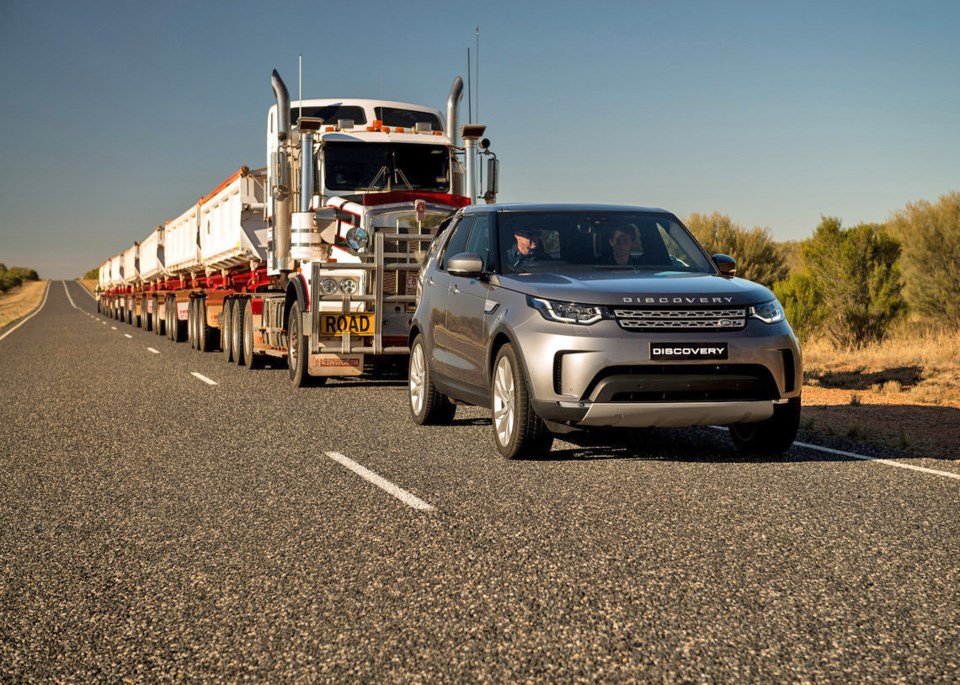Have you heard of the Australian concept called the road train? These are basically double versions of the “B-train” dump truck, with up to four trailers pulled by a single cab. In the Outback, there’s not much to hit, so these beasts just hammer along until they hit civilization, at which point they unload and pressure wash the bits of kangaroo off the front. I’m afraid that last bit isn’t a joke.
Anyway, anything suitably massive and wheeled will inevitably look like a PR stunt opportunity for a company that wishes to show how strong their trucks are. In this case, Land Rover was quickest to the punch, and hooked up an enormous seven-trailer road train to the back of a diesel-powered Discovery.
Total weight? Just about 110,000 kilograms. The Discovery’s 254 horsepower turbodiesel 3.0-litre was up to the job, however, and used all 443 foot-pounds of torque to pull the trailer 16 kilometres.
Mind you, don’t hook that ocean liner up to the back of your Disco just yet. Towing is as much about brakes as it is pulling power, and if you’re navigating the hilly terrain of British Columbia instead of the flat Outback, you might want to leave the heavy lifting to the tractor-trailers.
Maybe the Defender isn’t dead yet.
In other Land Rovery news, billionaire Jim Ratcliffe announced plans to start building a 4x4 modelled on the now-defunct Defender. Basically, the plan is to just copy the existing car, which has many fans for its rugged simplicity.
Having learned to drive in a Land Rover Series III at the age of eight, this sounds like both a good idea, and an extremely stupid one. The Defender is a wonderful car that turns even short trips into something resembling a safari. It has the refinement of a tractor, the ride of a tractor, the durability of a tractor, and, well, look ... it’s a bit agricultural.
The smart thing Mr. Ratcliffe is doing here is building a machine that adheres to the past, which he can sell to all sorts of wealthy English folks who wear wellies and tweed and buy organic cheese. The silly thing is that the days of the Defender are now past, and since you can fix old ones up by doing little more than shouting at them and hitting them with a large stick, maybe the Defender doesn’t need to get reborn.
Mitsubishi begins Evolution revolution
In Mitsubishi parlance, “Evolution” is added to cars (and one truck, the Pajero Evo) when they become homologation specials for rallying. However, with the death of the Lancer Evo some years back, Mitsubishi has effectively turned its back on performance. It’s now more an affordable crossover company.
With that in mind, the announcement of the e-Evolution electric crossover will make some Mitsubishi die-hard fans see red. Why not bring the Lancer Evo back? Well, because that’s not really the way the world is going. Mitsubishi is betting, correctly, that the future will belong to electric-powered crossovers that look as if they were designed by a shaving company.
Incidentally, Mitsubishi turns 100 this year. If they’re to last another century, they’ll have to evolve to embrace the electric-powered future. We’ll miss the crazy box flares and wings of the earlier Evos, but the e-Evolution is inevitable.
Porsche hints at Mission-E pricing
The Mission-E is Porsche’s first salvo against Tesla. A four-door sedan, it goes on sale in 2019, and will to take the fight to the Model S. It won’t be as quick as the Model S P100D in a straight line (figure 3.5 seconds to go 0-100 kilometres per hour for the Porsche), but will potentially be able to out-handle the Tesla.
We’ve already seen the concept, which boasted the ability to get 80 per cent of a charge in 15 minutes with its quick charge system, and now we’ve got an idea of cost. According to Oliver Blume, Porsche’s president, the Mission-E should cost about as much as an entry-level Panamera. In Canada, the Panamera starts at $97,300. A 75 kilowatt-hour Tesla Model S costs $98,150.
It would appear we’ve got an electric super sedan horse race, folks. Further, it’s my personal opinion that the Model S has supplanted the Porsche 911 as a symbol of entrepreneurial success in Vancouver. In the old days, you bought a whale-tailed 911 to show everyone how deep your pockets were. Now you get a Tesla. The dealership in the middle of Park Royal isn’t there by accident.
Porsche going straight for Tesla like this is good for the consumer, as the competition may soon result in cheaper electric machines for the rest of us. In the short term future, expect to see traffic over Lions Gate Bridge shift back towards Porsche badges.



